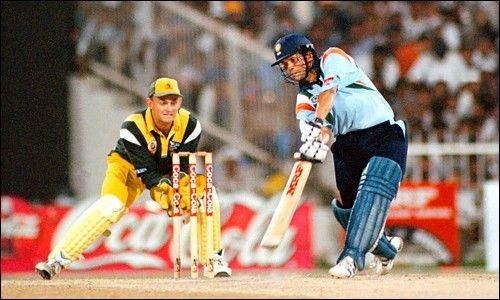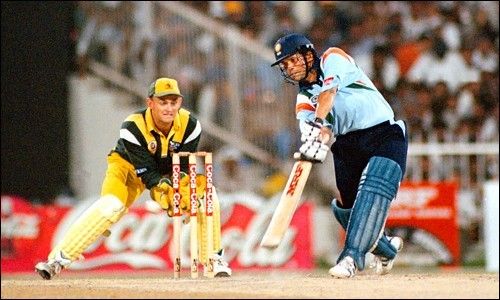
Decoding Sachin Tendulkar's finest knock - The Desert Storm

Sachin Tendulkar during the “Desert Storm”
The Desert Storm- A popular term given to a whirlwind knock played by a diminutive man against Australia at Sharjah. If there was ever a performance that could be used to describe the phrase ‘One man show’, this was it. It caused Tony Grieg to say that famous sentence on air,
“They are dancing in the aisles in Sharjah.”
Such outpouring of emotions by non-Indian commentators was uncommon in that era. India were looking to book a place in the finals of the tournament and they were set a target of 285 which was a huge total in that era. To knock New Zealand out and book a berth in the finals( which too was to be played against Australia), India had to go past 254. India had not beaten Australia in their previous group game and were heading towards a certain defeat.
When a sandstorm intervened just before the start of the 32nd over, India were placed precariously at 143/4. They’d just lost Ajay Jadeja and to make matters worse, they hadn’t scored a boundary in the previous ten overs. When play resumed, India were set a revised target of 276 in 46 overs for an outright win or 237 to qualify for the finals. The task in front of India was clear. 94 runs off 90 balls with six wickets in hand for a place in the finals.
All hopes rested on one man’s shoulders and when he came out to bat, it was an innings that would make him immortal in the annals of history. Tendulkar flayed the Australian attack in an unbelievable display of aggression that would’ve made the great Sir Viv Richards proud. Laxman was a mere spectator as Sachin raced away from 64 to 143 and in the process helped India qualify for the finals. With a place in the finals secured, Tendulkar then did the unthinkable when he went for the victory and while he was there, it looked possible. His gladiatorial instincts had been aroused. The wrinkles on the Aussie foreheads deepened as game headed for a manic finish with Sachin still at the crease.
On closer and repeated viewing of the footage, one will realize that it wasn’t mindless slogging that Sachin was executing. It was batting of the highest caliber that combined deft placement, some brute force, extraordinary running and that dreaded single of the last ball of the over to retain the strike! You could watch Sachin panting for breath as he dashed between the wickets for those twos. After each boundary, he simply tapped the surface of the wicket. If there was tension, he was definitely doing a good job of not betraying it.
When Sachin was finally dismissed, India had comfortably qualified for the finals. He had taken India to within 34 runs of glory with three overs still remaining. In 14 overs, Tendulkar and Laxman had added 104 vital runs with Laxman scoring just 20 of those. The gulf in the class of Sachin and his teammates was evident when the next pair added just 8 runs in the final 18 balls.
Tendulkar’s dismissal was a dodgy affair and there was a lot of confusion. But when he chose to walk, it was a statement that the battle had been won. The psychological battle. It was almost as if he was smirking behind that poker face of his and saying to the opposite camp- “See you boys in a couple of days!”
This knock prompted the famous observation from the Aussie side,
“He peaked too early.”
But on the day of the final, on his 25th birthday, Sachin played another breathtaking knock to win India the game and with that, the tournament. In a matter of three days, he had singlehandedly won India a One Day tournament and earned the admiration and adulation of fans across the world. These two knocks are widely regarded as two of best one day innings and I second that view.
As an observer, I’m more concerned about the statistical data that these Desert Storm knocks generated. And what I found after a little digging was quite impressive. These stats that I’m about to present show why Tendulkar was such a genius and why these two hundreds were impressive feats.
Back in the 90s, 270 was an impressive score. And in the final two games against Australia in the tournament, India were set 285 and 272. Teams in the 90s had an 80% chance of winning a game after posting a total in excess of 270. So before even starting their chase, India were battling odds that were massively favoring the opposition. In that decade, before 22nd April 1998, a total in excess of 270 had been set 107 times but had been chased successfully on only 17 occasions.
The first decade of the new millennium was remarkably different from the last decade. In the new decade, a total in excess of 300 was chased down 27 times. And a total in excess of 270 was chased down 90 times. This just goes to show the kind of influence that various new forms of the game have had on the batting styles of the batsmen of the new era. So it is safe to consider that a 270 in the 90s was as good as a 325 or a 330 of the next decade.
Another remarkable feature was Tendulkar’s batting in the 90s. Tendulkar of the 90s was a different beast altogether. Nearly impossible to stop. He amassed a massive 9660 runs at 43 and in the process helped himself to a cool 27 hundreds and 49 fifties. And these are just his One Day International figures (I can’t get myself to add up his ODI and Test numbers!!). Needless to say, he was head and shoulders above his peers. He was the only individual in that decade to record two consecutive centuries against the Australians in two successive matches. And he did that in some style.
Most people who’ve seen Tendulkar bat in the 90s will surely agree that he was far more aggressive in this decade than at any point later in his career. And his hundreds displayed that. In that decade, he scored 5 centuries against the Australians. 4 of those 5, came in winning causes. The one that came in the lost cause, came to be known as the Desert Storm. Another interesting stat is that 4 of those 5 centuries came at better than a run a ball. Which means he was striking in excess of 100. In fact, 18 of his 27 hundreds in that decade came at better than 90 runs/100 balls. Scoring runs at such strike rates with such consistency spoke a million words about the man’s skills.
It just goes to show what a genius this man was. He did have to remodel his game after the toe surgery and the tennis elbow, but he was still a force to reckon with. May be not as fierce as his Desert Storm days, but a force nevertheless. It wasn’t without reason that they called him God and it wasn’t without reason why Tony Greig went:
“Straight down the ground, all the way for six! What a playya!”
What a player indeed.